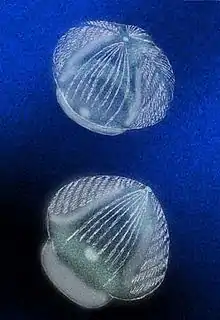| Fasciculus Temporal range: | |
|---|---|
 | |
| Artist's reconstruction | |
| Scientific classification | |
| Domain: | Eukaryota |
| Kingdom: | Animalia |
| Phylum: | Ctenophora |
| Genus: | †Fasciculus Simonetta & Delle Cave, 1978 |
| Species: | †F. vesanus |
| Binomial name | |
| †Fasciculus vesanus Simonetta & Delle Cave, 1978 | |
Fasciculus vesanus is an extinct species of stem-group ctenophores known from the Burgess Shale of British Columbia, Canada. It is dated to 515 to 505 million years ago and belongs to middle Cambrian strata.[1]
The species is remarkable for its two sets of long and short comb rows, not seen in similar form elsewhere in the fossil record or among modern species.
See also
Maotianshan shales ctenophores
References
- ↑ S. Conway Morris & D. H. Collins (1996). "Middle Cambrian ctenophores from the Stephen Formation, British Columbia, Canada". Philosophical Transactions of the Royal Society B: Biological Sciences. 351 (1337): 243–360. doi:10.1098/rstb.1996.0024. JSTOR 56388.
External links
- "Fasciculus vesanus". Burgess Shale Fossil Gallery. Virtual Museum of Canada. 2011. Archived from the original on 2020-11-12.
This article is issued from Wikipedia. The text is licensed under Creative Commons - Attribution - Sharealike. Additional terms may apply for the media files.